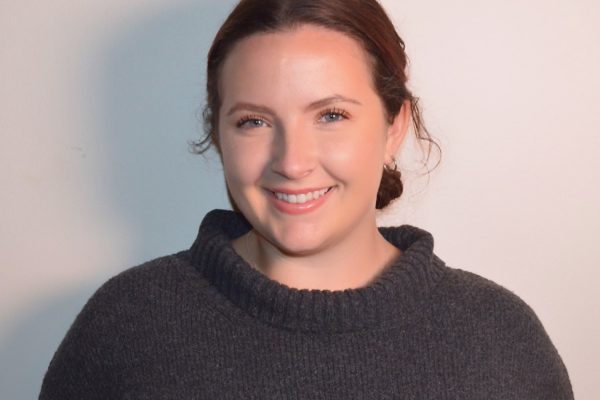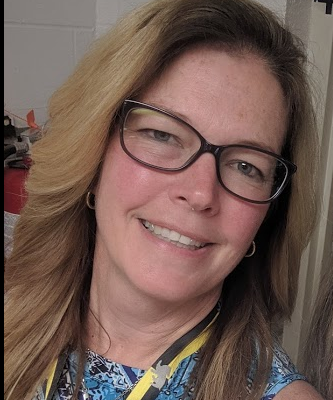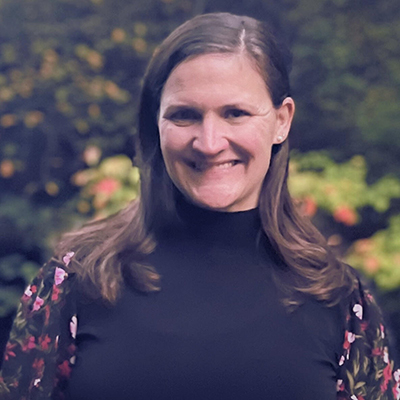“Wow! No way! Wait, how do I do this?”

Students viewing each other’s 360° photography.Photo by Fred Haas
After some basic instruction, an art student at Hopkinton High School explores this new virtual environment. While it takes some time to gain familiarity with these new tools, students are mesmerized by the experience. The simulated ability to move around and even through the artistic creations provides instant appeal with plenty of gleeful comments and giggles.
Experiencing 3D Digital Art
The students are learning how to use a combination of hardware and software that allows them to create three-dimensional virtual art digitally. While 3D art has existed for millennia, creating it in a digital form to be experienced in a virtual reality setting is relatively new.
“This is a lot easier than sculpting because you’re not dealing with actual material,” junior Selia Potas said. “It allows you to change it and manipulate it in a way that you can’t in real life.”
The technology required to set up the experience involves some key hardware, including a powerful laptop equipped with the HTC Vive system to create the fully immersive experience. The Vive system is comprised of a headset and controllers for the user, as well as base stations that track and synchronize all the user’s movements. Combining this setup with software like Google TiltBrush and Google Blocks allows anyone to begin digitally creating 3D art in a virtual reality environment.
“It’s really cool. You just feel like you are in a different world,” said sophomore Carly Sanderson. “Right here, you can see it just [on the classroom screen] but inside you can see everything in your peripheral vision.”
Worrell noted, “They all begin creating in 2D and you really need to coach them into working a 3D way.” “When you are just drawing something on paper it’s 2D, but when you are using [the virtual reality system], it’s like you are creating different 3D objects that you can’t create in the real world,” said Sanderson. “I feel like even if you had more of a sculptural background you would still struggle because you can’t feel it instead of pressing buttons.”

MassCUE Grant Application Process is open until December 1, 2018
Funding the Experience
HHS Photography teacher Sterling Worrell secured the equipment through a MassCUE Classroom Grant.
“I was intrigued with the technology and the potential to use it in the art classroom. I wanted students to create content in 3D, not just consume it,” Worrell said. “They play first-person games and watch 3D videos, and I wanted them to understand that they could create those kinds of things too.”
In fact, graduating senior Lily Hanks recently created 360° photographs of polluted areas in Hopkinton as part of her independent senior project. While Hanks’ project made use of different VR technology, “She is making these photographs and people will be able to see these areas in virtual reality,” Worrell said.
VR Challenges in the Classroom

Painting in 3D for the first time. Photo by Fred Haas
Still, working in this new environment that combines 3D and virtual reality with new devices is not without its challenges. Sanderson found getting used to the tools and realizing the possibilities continues to be the most challenging part. “You can go forward and back, not just side to side. You can go through it,” Sanderson explained. “I thought it was really cool that you were able to paint in a 3D way. Normally, you can only paint in a 2D way,” freshman Alyssa Souza added. “At first, I didn’t completely know how to use all the tools but then I got used to it pretty quick.”
“There are issues with space and safety. Some kids get into this world and forget that there is furniture in the room. Some kids get vertigo. So I feel like I really need to keep an eye on them when they are using it,” Worrell said. Worrell hopes that there will be a point when the new setup will be just another creative option in art classes where students can opt to make virtual reality art for the session. This will take some time to develop as there are additional challenges to making the new setup work in the classroom.
Regardless, Worrell and the students are eager to keep experimenting and pushing the boundaries of the forms of art students can create.
Potas summed things up best. “This is really cool. I’ve never really experienced anything like this before. I think a lot of people can enjoy this because it has so much potential.”
Adapted from original article by Fred Haas, Reprinted with permission from HPS Digital

Sterling Worrell guiding student in use of Google Tilt Brush. Photo by Fred Haas
Sterling Worrell teaches Photography at Hopkinton High School. Follow him on Twitter @snorthw
 Print this post
Print this post




